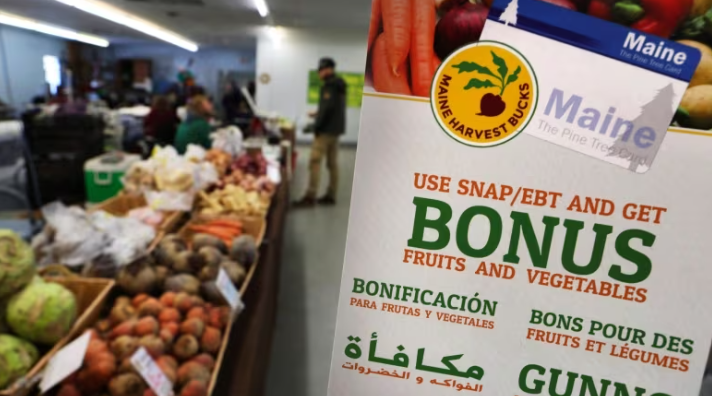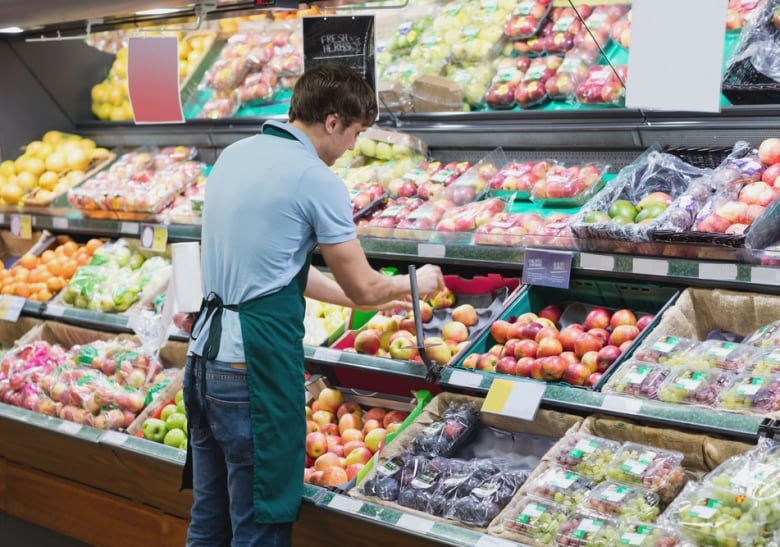The U.S. uses a food stamp program to tackle food insecurity. Should Canada?

In 2022, more than 41 million people in the U.S. purchased food with SNAP benefits
West Virginian Meghan Hullinger is a single mother of four who, despite working a full-time job, says she has only about $45 left over each month after paying most of her basic living expenses.
So for the past six years, Hullinger has been using a government issued debit card at her nearby grocery to purchase food for her family.
She is one of the millions of Americans who use that card as part of the U.S. Supplemental Nutrition Assistance Program (SNAP) — a federal food security program run by the U.S. Department of Agriculture (USDA) that provides monthly funds specifically for people to buy food. SNAP households are expected to spend about 30 per cent of their own resources on food. In 2023, the estimated average benefit for one person was around $195 per month.
“Without this program, not just families like mine, but literally thousands of families in America would be on the brink of starvation,” she said. “That’s literally how we eat. I think that the program is so beneficial for families like mine.”
In 2022, more than 41 million people in the U.S. purchased food with SNAP benefits, considered the largest program working to fight hunger in America.
The program, known to many by its earlier iteration “food stamps,” in which recipients used actual coupons to purchase food, has no similar nation-wide equivalent in Canada. And while many U.S.-based food security experts laud SNAP, some of their Canadian counterparts don’t believe the country would benefit from a similar program that offers assistance tied specifically to food.

“It’s been shown that people who receive SNAP are better off than people that don’t,” said Valerie Tarasuk, a professor in the Department of Nutritional Sciences at the University of Toronto, who also leads PROOF, a research program investigating policy interventions to reduce food insecurity in Canada.
“But still, a substantial proportion of people who receive SNAP are food insecure.”
It can be difficult to compare food insecurity rates country to country, based on methodology and definitions. In Canada in 2022, according to PROOF, 6.9 million people in the 10 provinces, including almost 1.8 million children, lived in a food-insecure household.
Last year, a record number of people used food banks in Canada, and about a third of them are children.
Meanwhile, the USDA data show that in 2021, 13.5 million U.S. households were food insecure at some time during the year.
‘One of the largest tools’
Yet some advocates suggest those numbers would be worse if not for SNAP.
“The reality is, is that it’s the most responsive federal program we have that provides assistance to families,” said Elyssa Schmier, a spokeswoman for MomsRising, a U.S. based advocacy group working to increase family economic security..
“It’s also one of the largest tools we have to combat poverty and hunger in the country.”
“I know that families in Canada are struggling. It was very surprising to hear that [Canada doesn’t] have any sort of dedicated nutrition programs in place, especially to help families with children.”
SNAP advocates cite studies that suggest the program does reduce food insecurity.
Researchers at the Urban Institute, for example, used national survey data from the late 1990s and early to mid-2000s to show that SNAP reduces the likelihood of being food insecure by roughly 30 percent.
Lauren Bauer, a fellow in Economic Studies at the Brookings Institution whose expertise includes federal nutrition assistance programs said it’s self evident that when you give families sort of dedicated resources to purchase food, they then spend more of their household budget on food.
“Food security goes up, food insecurity goes down and hunger … goes down.”
Bauer said other research has shown that SNAP has benefited child development, lead to increased high school graduation rates, and financial independence.
“It’s clear evidence that the way SNAP itself works, that SNAP is one of the causes of that.”

The program does have its critics. Republicans have decried the cost, which in 2023, is expected to be around $127 billion. And some suggest that too much of the benefits are used for unhealthy food, fuelling obesity problems in the country.
Others complain that the amount people receive isn’t enough and needs to be boosted. Indeed, a big area of disagreement during the debt-ceiling deal was work requirements for SNAP, which will be increased under the agreement, but certain vulnerable groups were exempted.
Matthew Little, assistant professor in the School of Public Health and Social Policy at the University of Victoria, said that funnelling money to existing income supports would be much more prudent than a new government program that would come with a huge administrative burden.
Little said while SNAP may may alleviate food insecurity in the short term, it shouldn’t be considered a sustainable long term strategy. What needs to be addressed, he said, are the root causes of poverty by increasing wages, reducing wage inequality, progressive taxation schemes and income supports.
“And that’s kind of the strategy that we’ve taken more generally in Canada to poverty alleviation which is kind of the reason why we don’t have this food assistance is that we take a cash-based approach in Canada,” he said.
“I’m supportive, I think, of that strategy because it provides more freedom and choice to the consumers to be able to make the financial decisions that they want to make depending on their needs at the household level.“
Why tie assistance to food?
Tarasuk agreed that increasing the amount of benefits already in place, she said, would be much more efficient that creating a whole new infrastructure for SNAP.
She said there’s no need to tie the cash benefit specifically to food, and that their research has found no evidence that people who are food insecure wouldn’t spend money on food if they were just given a a cash benefit.
“There’s no no evidence in the United States or Canada that says we’re better off tying a benefit to food purchasing than just giving them a benefit,” she said.

For example, her research found a one-third drop in the prevalence of severe food insecurity among families with children following implementation fo the Canada Child Benefit, a federal subsidy meant to help with the cost of raising children.
But Bauer said the problem with cash benefits is that they’re not as well targeted and are not based on a market basket of groceries, which allows the SNAP program to adjust to rising food costs.
“So the way the benefit is actually calculated is meant to be about food,” she said. “And these untargeted programs, because that’s not incorporated into any calculation, are kind of untethered to reality.”
Related News
Trade war, slumping border traffic: What does that mean for the Gordie Howe bridge?
Amid U.S. President Donald Trump’s tariffs which have triggered a trade war with Canada, cross-border trips haveRead more
Trump administration threatens Harvard’s foreign enrolment, tax-exempt status
U.S. Homeland Security Secretary Kristi Noem speaks during an event on April 9, in Washington,Read more
